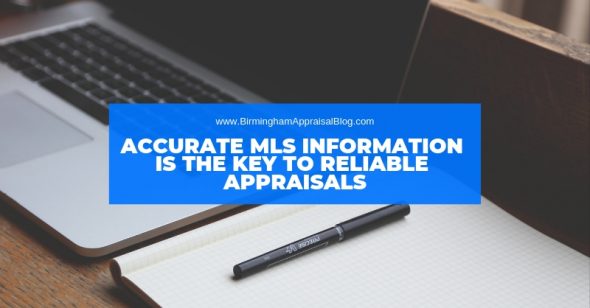Accurate MLS Information Is Necessary For Reliable Appraisals
 Have you heard the old saying “garbage in garbage out”? Do you know what it means?
Have you heard the old saying “garbage in garbage out”? Do you know what it means?
It basically means that the quality of output is determined by the quality of input. In appraising this means that the quality of our appraisal results is a direct result of the quality of the information that we use.
The success of appraisers and real estate agents is directly related to the quality of information that each produces. Appraisers rely on the information provided by our local MLS offices and the more accurate and complete it is the better.
Accurate information helps home appraisers produce the most reliable appraisals that reflect what is happening in the market. These appraisals are then used by lenders and agents to help sell and finance homes.
It goes without saying that the more accurate an MLS listing is the better quality the appraisal report is. In addition, the more complete a listing is the more data the appraiser will have to measure the market with and to develop their adjustments for their reports.
Accurate MLS Information Helps With Adjustments
One of the most common questions I get from real estate agents is regarding adjustment amounts. They want to know how much a pool is worth or how much value a finished basement adds.
I always explain to them that there is no rule of thumb on adjustments. They will vary depending on where the property is along with other factors. There is no “little black book of adjustments” that will work all the time and for all properties.
property is along with other factors. There is no “little black book of adjustments” that will work all the time and for all properties.
Appraisers determine the various adjustment amounts by analyzing information about the sales comparables. The information they analyze is what is included in the MLS so as I said the more information that is included in the listing the better analysis appraisers can do and the more reliable their findings will be.
So you may be asking “what type of information should be included in the MLS”? My answer to that is “as much information as possible”!
Seriously, though, the more information the better. This is especially true of the features that we know has a direct influence on value like the living area.
Square Footage Should Be Accurate
It’s very important for square footage information to be accurate. I have found that the accuracy of square footage varies wildly in MLS listings based on where the information is obtained.
 In my own market, square footage information is typically obtained from three main sources, which are public records, house plans, and the appraiser. As you might expect, information obtained from house plans and the appraiser are typically the most accurate and therefore produce the best results when calculating the price per square foot adjustments.
In my own market, square footage information is typically obtained from three main sources, which are public records, house plans, and the appraiser. As you might expect, information obtained from house plans and the appraiser are typically the most accurate and therefore produce the best results when calculating the price per square foot adjustments.
While square footage adjustments are usually the most common adjustments there are other features that move the needle on value too. Examples include swimming pools, bedrooms, bathrooms, basements, storage buildings/barns, garages, etc.
By including as much data as possible in the MLS it makes it possible to determine if a feature contributes to value. That is why it is important to include this information because the appraiser can use various tools including regression analysis to help determine adjustments.
You Can’t Measure It If It’s Not Described
One feature that has been in the news lately is solar power. People want to know if a home equipped with solar panels will sell for more than a house that does not have it.
The only way for an appraiser to determine whether solar power contributes to value is to have sufficient information available within the MLS. This means that there should be a field for solar so that the appraiser can sort and analyze this data. I should also add that only solar systems that are owned will contribute to value.
If it is a leased system it will not contribute to the properties appraisal value. It would be a good idea to also have a field that describes whether it is owned or leased.
As you can see, appraisers can measure the contributory value of any feature as long as that feature is described within the MLS and it can be sorted and analyzed. This is a good incentive for agents to be as accurate and as complete as possible when putting together their MLS listings because you can’t measure what’s not noted or described.
Conclusion
Do you have any other questions about the importance of accurate MLS information? Leave a comment below and we’ll keep the conversation going. As always, thanks for reading.
I find it interesting that many appraisers do not verify the information they glean. The information from the MLS is not always accurate, and often times with the square footage, it comes directly from the Assessor Records which may be where the inaccuracies start from. USPAP requires that we verify our information; to me that means to speak with a Realtor, seller or buyer. To call a corroboration of the data of public records and MLS data a verification is not appropriate; for one you have not idea of the impetus of the buyer and status whether it is arms length.
Kudos on the solar info! This is a huge deal going forward! Out here the SF issue is especially important with regard to guest houses and pool houses, and I suspect in other areas, the basement is a big deal. Love reading your blogs!
Thanks, Glen. We do have some guest houses and pool houses here, too. Basements are very common so it is important that we get that right. Thanks for reading.
Yes, we love accuracy. We also love having as many photos as possible. I appreciate your sentiment that we cannot measure it if we don’t know about it (or if it’s not accurate as you stated). This is especially true with solar systems. If we don’t have the right details, it’s very difficult to assign value.
Thanks, Ryan. I think it is important that we have a good relationship with our local MLS’s so they know how important this stuff is and hopefully, they can help these things be included in their MLS information.
Most realtors include lower level baths, rec rooms and/or bedrooms etc in their total room count which is wrong but makes the listing seem better than it is. They also tend to include lower level finished area in their overall GLA which is also wrong. They do it to enhance the listing. I never rely on the data from the MLS. I ALWAYS check it against the county records and go from there. Some day an appraiser should teach a class to all realtors on how to insert the correct data.
Sounds like the agents in both of our areas are the same. I will say that in our area the agents do try and segregate the GLA and basement finished area but they are not as diligent with the room counts. I do try and educate agents about this whenever I speak at their office.
Thanks for covering this very important topic. This situation has always concerned me. I have personally experienced what you have discussed with both data analysis and also comp selection. I have missed finding some very good comparable sales at times because the data on that sale was completely incorrect. I also appreciate your point that inaccurate data can skew our adjustments, which we usually derive from data taken from the MLS. Thanks as always for a great article.
Thanks for sharing your experience as well, Jamie. Seems like we have had similar experiences. Better data always produces better appraisals. The crazy thing is that this type of thing will probably be worse with the new automated evaluations because there will not be a live person to verify the information and it will just get passed along like it is correct therefore corrupting the end result.
Agree Tom all these Big Data systems rely on public record data unless they have access to MLS and appraisals and public (assessor data) can be unreliable at times especially in rural areas, but I’m sure Corelogic has all the answers and will own all the data eventually for automated ?? whatever they come up with anyways.
Yeah, I guess that is a valid concern with CoreLogic. I know that with some homes their information will be accurate but there are still some that they will not have accurate information on and they will need boots on the ground appraisers to look at and value the property.
Dan – you bring up an important issue – CoreLogic’s role in Big Data. This past year I discovered that it is CoreLogic that collects the Assessor’s data once a year by obtaining downloaded files of property data characteristics, then reformats the data, and uploads that data to our local MLS. I suspect they are doing the same across the country. What was telling was that the wrong field was being reference for GLA, hence many discrepancies between the true Assessor data and what is purportedly “public data” available through the MLS (data Agents think is the public data). I have been working with CoreLogic to resolve this issue, and to reformat the data they obtain from our County. We update our data nightly, so updating only once a year only captures the data for that specific point in time. With that said, we are making ever effort to address many of the above issues and more as we work to improve or enhance our data and make sure third-party users (such as CoreLogic, MLS, Agents, the Public, etc.) understand what it does and does not include. Likewise, I attempt to educate REALTORs on the importance of accurate data, and encourage them to contact us regarding any discrepancies they believe to exist when comparing it to public records.